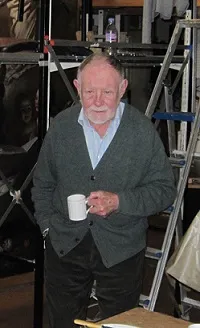Obituary: Robert Shepherd
Submitted by campbell on 25 Apr 2019

By Simon Howell
Robert was born in South Africa leaving in 1954 to study Fine Art at the Slade School in London. It was there that he met Arthur Lucas, Chief Restorer at the National Gallery, who taught the students methods and materials and gave him an early interest in the subject. After a brief stay in Amsterdam he returned to South Africa and the Durban Museum as a young curator of paintings, later moving to the Cape Town Museum, again as a curator of paintings. In Cape Town he took an interest in the restoration department and obtained a scholarship to be trained in Brussels at the Royal Institute for Cultural Heritage, (IRPA)*. IRPA was at this time one of the foremost European centres for restoration and was the first to open up to foreign students. During his time at IRPA Robert witnessed the international conference gathered to discuss the treatment of Rubens’ <em>Descent from the Cross</em> from Antwerp Cathedral. He also acted as their representative during a meeting in 1962 at the National Gallery in London; here he first met David and John Bull, Herbert Lank and Helmut Ruhemann, who were all at the National Gallery at the time. Of the many influences on his early career, Robert would often speak with great respect for Albert Philippot or ‘Monsieur Philippot’ as he was known, the chief paintings restorer at IRPA. During his time at IRPA Robert was involved in the first international art exhibition after the war, <em>Masterpieces of Flemish Art; Van Eyck to Bosch</em>**. This would fuel a love of early Flemish art that would be an enduring theme of his working life; an interest shared with his wife Ruth, who worked on the English translation of the catalogue.
Robert moved to London in 1963 and after a brief interlude at the Tate Gallery, when he was instrumental in their purchase of the first lining hot table, he took up a post at the National Gallery under Arthur Lucas. David Bull and John Hargrave were working there at the time, as was Helmut Ruhemann who had a private studio within the gallery. Robert and David Bull formed a good working relationship at the NG and Robert helped David out with private work during his spare time. Around 1965, first David and then Robert left the National Gallery and set up a private studio together, first working out of David’s front room in his Wimbledon flat and then eventually building a purpose-built studio in David’s garden.
Robert and David’s practice quickly developed, their surnames providing the epithet of, ‘The Young Farmers.’ Their success was in part due to their ability to satisfy the demand for European old master paintings for the burgeoning museums of North America. During this period Richard Watkiss, Simon Bobak and Di Reeves among others, passed through the studio and were later to have successful careers in the profession. David left in 1978 to go to the Getty Museum in California leaving Robert to carry on the business alone, eventually becoming Shepherd Conservation.
From the early 1970’s Robert became very involved with the Association of British Picture Restorers, (ABPR)*** and the International Institute for Conservation, (IIC) where he was on its council from 1982-1990. During his time working on behalf of the profession he campaigned for an open dialogue between restorers, working to break down the various divisions within the field, a strong theme for those in the profession who had lived through World War II. In this regard, he always felt that his background as an ‘outsider’, (having come from South Africa and training outside the UK) was a particular advantage.
Above all, it was his love of paintings that was at the heart of his practice and no day in the studio was ever complete without his insightful appraisal of a particular painting or artist.
A stroke in 2004 prevented him from carrying on an active role in the business, but he continued to come in to the studio on a daily basis, enlivening many coffee breaks with a seemingly endless supply of stories and anecdotes about his career and people he had met, (many too scurrilous to mention here!).
But any memory of him would not be complete without mentioning that he was a natural sportsman, playing rugby as fly-half for the Slade team and cricket in the summer. He took up sailing in his middle years and was an enthusiastic member of Thames Sailing Club, a world where he was known to all as ‘Bob’. I should also include the ritual Friday night game of snooker that took place for many years between Robert, John Bull and Peter Newman.
Although the stroke rather took the wind out of his sails in his later years, he did always love a good argument, often started a discussion with a provocative comment. Of his many, I remember, ‘… of course animals are far more important than humans’; on that note he leaves a trusted companion in Hogarth his fourteen-year-old Shih Tzu.
*KIK-IRPA was established in 1948 just after World War II.
**Detroit Institute of Arts, 1960. <em>Flanders in the fifteenth Century Art and Civilisation, Catalogue of the Exhibition, Masterpieces of Flemish Art: Van Eyck to Bosch</em>, Oct. – Dec. 1960. Detroit: The Detroit Institute of Arts.
***Later to become the British Association of Painting Conservator Restorers, (BAPCR).
The Anna Plowden Trust has been asked to administer a fund set up in memory of Robert Shepherd to provide scholarships and CPD grants. More information about these awards and how to donate can be found <a href="https://www.iiconservation.org/content/robert-shepherd-memorial-fund-scholarships-cpd-grants"